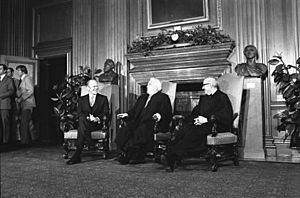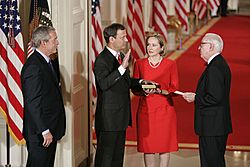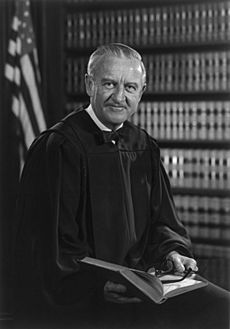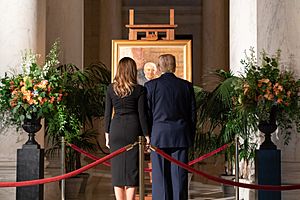John Paul Stevens facts for kids
Quick facts for kids
John Paul Stevens
|
|
|---|---|

Official portrait, 2006
|
|
| Associate Justice of the Supreme Court of the United States | |
| In office December 19, 1975 – June 29, 2010 |
|
| Nominated by | Gerald Ford |
| Preceded by | William O. Douglas |
| Succeeded by | Elena Kagan |
| Judge of the United States Court of Appeals for the Seventh Circuit | |
| In office November 2, 1970 – December 19, 1975 |
|
| Nominated by | Richard Nixon |
| Preceded by | Elmer Jacob Schnackenberg |
| Succeeded by | Harlington Wood Jr. |
| Personal details | |
| Born | April 20, 1920 Chicago, Illinois, U.S. |
| Died | July 16, 2019 (aged 99) Fort Lauderdale, Florida |
| Resting place | Arlington National Cemetery |
| Political party | Republican |
| Spouses |
Elizabeth Sheeren
(m. 1942; div. 1979)Maryan Mulholland Simon
(m. 1979; died 2015) |
| Children | 4 |
| Education | |
| Civilian awards | Presidential Medal of Freedom (2012) |
| Signature |  |
| Military service | |
| Branch/service | United States Navy |
| Years of service | 1942–1945 |
| Rank | |
| Battles/wars | World War II |
| Military awards | |
John Paul Stevens (April 20, 1920 – July 16, 2019) was an American lawyer and judge. He served as a Supreme Court Justice from 1975 to 2010. When he retired, he was one of the oldest and longest-serving justices in the history of the U.S. Supreme Court. He also lived longer than any other Supreme Court justice.
During his long time on the Court, Justice Stevens wrote opinions on many important topics. These included civil liberties, the death penalty, and rules about government actions. Even though he was a registered Republican and thought of himself as conservative, many people saw him as a liberal voice on the Court when he retired.
Born in Chicago, Stevens joined the United States Navy during World War II. After the war, he went to Northwestern University School of Law. He worked for Justice Wiley Rutledge before starting his own law firm. In 1970, President Richard Nixon chose Stevens to be a judge on the United States Court of Appeals for the Seventh Circuit. Five years later, President Gerald Ford nominated him to the Supreme Court. He took the place of Justice William O. Douglas. Stevens retired in 2010 and was replaced by Elena Kagan.
Some of his important majority opinions were in cases like Sony Corp. of America v. Universal City Studios, Inc. and Hamdan v. Rumsfeld. He also wrote strong disagreements (called dissents) in cases like Texas v. Johnson and Citizens United v. FEC.
Contents
Life and Career of a Justice
Early Years and Education (1920–1947)
John Paul Stevens was born on April 20, 1920, in Chicago, Illinois. His family was wealthy. His father was a lawyer and later owned hotels. During the Great Depression, his family lost their hotels. His father and other relatives faced legal trouble, but the charges were later overturned.
Stevens was a big fan of the Chicago Cubs baseball team. When he was 12, he saw Babe Ruth's famous "called shot" during a game. He also met famous people like aviators Amelia Earhart and Charles Lindbergh.
He went to the University of Chicago Laboratory Schools and then the University of Chicago. He studied English and graduated with high honors in 1941.
In 1941, he joined the United States Navy. He served as an intelligence officer in the Pacific Ocean during World War II. He helped with codebreaking that led to an important event in 1943. For his service, he received the Bronze Star.
Stevens married Elizabeth Jane Shereen in 1942. They later divorced. In 1979, he married Maryan Mulholland Simon. She passed away in 2015. He had four children.
After World War II, Stevens decided to study law. He went to Northwestern University School of Law and graduated in 1947. He was first in his class.
Becoming a Lawyer (1947–1970)
After law school, Stevens worked as a law clerk for Supreme Court Justice Wiley Rutledge. This was from 1947 to 1948.
Then, Stevens returned to Chicago and joined a law firm. He focused on antitrust law. This type of law deals with preventing businesses from unfairly limiting competition.
In 1951, he worked for a committee in the U.S. House of Representatives. This committee looked into monopolies in different industries, including Major League Baseball.
In 1952, Stevens started his own law firm in Chicago. He became known as a skilled antitrust lawyer. He also taught a course on "Competition and Monopoly" at the University of Chicago Law School.
In 1969, Stevens was chosen to lead an investigation into corruption allegations against judges in Illinois. He did a thorough job, and the judges were eventually forced to leave office. This work made him well-known.
A Judge's Journey (1970–2010)

Because of his work on the corruption investigation, President Richard Nixon appointed Stevens as a judge. This was for the United States Court of Appeals for the Seventh Circuit in 1970.
On November 28, 1975, President Gerald Ford nominated Stevens to the U.S. Supreme Court. He was confirmed by the U.S. Senate with a vote of 98–0. He officially joined the Court on December 19, 1975.
When Justice Harry Blackmun retired in 1994, Stevens became the senior associate justice. This meant he took on some administrative duties when the Chief Justice of the United States position was empty. For example, he acted as chief justice for a short time in 2005 after Chief Justice William Rehnquist passed away.

In 2005, President Ford praised Stevens. He said Stevens was serving the nation with "dignity, intellect and without partisan political concerns." Stevens also said that he learned a lot "on the job" and changed his mind on some issues, like affirmative action.
On January 20, 2009, Stevens gave the oath of office to Vice President Joe Biden.
On April 9, 2010, Stevens announced he would retire from the Supreme Court. He officially retired on June 29, 2010. He said he decided to retire after stumbling over some words during a dissent in a case. He saw it as a sign that it was time to step down.
Years of Service and Age

Stevens retired as the third-longest-serving justice in Supreme Court history. He served for 34 years and six months. Only Justice William O. Douglas served longer.
He was also the second-oldest justice at retirement, at 90 years old. On July 23, 2015, Stevens became the longest-lived retired justice ever.
Political Views
When he was appointed to the Supreme Court, Stevens was a registered Republican. However, over time, his views often aligned with the more liberal side of the Court.
A close friend said that Stevens avoided discussing politics as a judge. In 2018, Stevens said that Brett Kavanaugh's performance during Senate hearings should disqualify him from the Supreme Court. Stevens believed Kavanaugh showed too much political bias.
Just before he passed away, Stevens said he was "not a fan of President Trump." He also said Trump's effect on the country had "not been favorable."
How Justice Stevens Approached the Law
His Judicial Philosophy
Early in his Supreme Court career, Stevens had a moderate voting record. He initially supported the death penalty and opposed race-based admissions programs. However, he later joined the more liberal justices on issues like gay rights.
Stevens's approach to law was often unique. Unlike most justices, he reviewed petitions for cases himself. He also wrote the first drafts of his opinions. He explained that he learned more about cases and legal ideas as he wrote his opinions.
He was not an originalist, meaning he didn't believe the Constitution should only be interpreted based on its original meaning. He was considered part of the liberal group of justices starting in the mid-1980s. Even so, he called himself a "judicial conservative" in 2007.
Stevens changed his mind on affirmative action. He initially opposed it, but later voted to support an affirmative action program at the University of Michigan Law School in 2003.
He wrote the majority opinion in Hamdan v. Rumsfeld (2006). This case said that certain military trials were not set up correctly. He also wrote a long dissenting opinion in Citizens United v. FEC. He believed this decision was "a disaster for our election law."
Freedom of Speech
Stevens generally supported students' right to freedom of speech in public schools. He wrote strong disagreements in cases like Bethel v. Fraser and Morse v. Frederick. These decisions limited students' free speech. However, he agreed with the Court's ruling in Hazelwood v. Kuhlmeier, which allowed a principal to censor a student newspaper.
Stevens, a World War II veteran, strongly disagreed with flag burning. He voted to uphold a ban on flag burning in Texas v. Johnson. He wrote that the flag symbolizes important ideas like liberty and equality. He felt it deserved protection from disrespect.
Religion and Government
In Wallace v. Jaffree (1985), Stevens wrote the opinion that struck down an Alabama law. This law required a minute of silence in public schools for "meditation or silent prayer." He said the First Amendment means the government cannot favor one religion over another. It must respect everyone's freedom to choose their own faith, or no faith at all.
Stevens also wrote a dissent in Van Orden v. Perry (2005). He argued that displaying the Ten Commandments on the Texas Capitol grounds suggested the state supported a specific religious belief. He believed the Establishment Clause requires the government to be neutral about religion.
Government Power and States' Rights
When interpreting the Interstate Commerce Clause, Stevens usually sided with the federal government. This clause gives Congress power to regulate trade between states. He disagreed in cases like United States v. Lopez and United States v. Morrison. In these cases, the Court limited Congress's power under the Commerce Clause.
Search and Seizure (Fourth Amendment)
Stevens generally supported individual rights when it came to the Fourth Amendment. This amendment protects people from unreasonable searches and seizures. He wrote the majority opinion in Arizona v. Gant. This case limited when police can search a car after arresting someone.
He disagreed in cases like New Jersey v. T. L. O. and Vernonia School District 47J v. Acton, which involved searches in schools. However, he did side with the government in some cases, showing his independent thinking.
The Death Penalty
Stevens initially joined the majority in Gregg v. Georgia (1976). This decision allowed the use of the death penalty again. However, after he retired, Stevens said that this was the only vote he regretted during his time on the Court.
Other Important Decisions
Chevron Deference
Stevens wrote the majority opinion in Chevron U.S.A., Inc. v. Natural Resources Defense Council, Inc. (1984). This case is very important for how courts review decisions made by government agencies. It says that if a law is unclear, courts should usually respect the agency's interpretation of that law. This is known as "Chevron deference."
Bush v. Gore
In Bush v. Gore (2000), Stevens wrote a strong disagreement with the Court's decision. The Court stopped the recount of votes in Florida during the 2000 presidential election. Stevens believed this decision showed a lack of trust in state judges. He wrote that the true loser of the decision was the nation's trust in judges.
Second Amendment
Stevens wrote the main dissenting opinion in District of Columbia v. Heller (2008). This was a major case about the Second Amendment and the right to keep and bear arms. The Court ruled that the Second Amendment protects an individual's right to own a firearm for self-defense at home.
Stevens argued that the Court's decision was a "strained and unpersuasive reading" that overturned past rulings. He believed the Second Amendment was mainly about state militias, not individual gun ownership for any purpose. He also pointed out that the Founders did not specifically mention using firearms for hunting or self-defense in the amendment.
In 2018, after large demonstrations for gun control, Stevens wrote an essay. He suggested that people should demand the complete repeal of the Second Amendment.
Books by John Paul Stevens
In 2011, Stevens published a book called Five Chiefs: A Supreme Court Memoir. It talks about his legal career under five different chief justices.
In 2014, he published Six Amendments: How and Why We Should Change the Constitution. In this book, he suggested six amendments to the U.S. Constitution. These included changes for political gerrymandering, campaign finance reform, and capital punishment. He also suggested changes for gun violence.
In 2019, shortly before he passed away, Stevens published The Making of a Justice: Reflections on My First 94 Years.
Personal Life
Stevens married Elizabeth Sheeren in 1942. They divorced in 1979. Later that year, he married Maryan Simon. They were married until her death in 2015. Stevens had four children, two of whom passed away before him.
He was a Protestant. After his retirement, the Supreme Court had no Protestant members for the first time in its history. He was also an enthusiastic bridge player.
His Passing
John Paul Stevens passed away at age 99 on July 16, 2019. He died from complications of a stroke in Fort Lauderdale, Florida. He was with his two surviving daughters when he died. He also had 9 grandchildren and 13 great-grandchildren.
His body lay in repose at the Supreme Court on July 22, 2019. He was buried at Arlington National Cemetery on July 23, 2019. All the current justices and retired justices attended his service. President Donald Trump ordered flags to fly at half-staff to honor him.
See Also
 In Spanish: John Paul Stevens para niños
In Spanish: John Paul Stevens para niños



